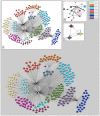Comparative transcriptome analysis of two olive cultivars in response to NaCl-stress
- PMID: 22952621
- PMCID: PMC3431368
- DOI: 10.1371/journal.pone.0042931
Comparative transcriptome analysis of two olive cultivars in response to NaCl-stress
Abstract
Background: Olive (Olea europaea L.) cultivation is rapidly expanding and low quality saline water is often used for irrigation. The molecular basis of salt tolerance in olive, though, has not yet been investigated at a system level. In this study a comparative transcriptomics approach was used as a tool to unravel gene regulatory networks underlying salinity response in olive trees by simulating as much as possible olive growing conditions in the field. Specifically, we investigated the genotype-dependent differences in the transcriptome response of two olive cultivars, a salt-tolerant and a salt-sensitive one.
Methodology/principal findings: A 135-day long salinity experiment was conducted using one-year old trees exposed to NaCl stress for 90 days followed by 45 days of post-stress period during the summer. A cDNA library made of olive seedling mRNAs was sequenced and an olive microarray was constructed. Total RNA was extracted from root samples after 15, 45 and 90 days of NaCl-treatment as well as after 15 and 45 days of post-treatment period and used for microarray hybridizations. SAM analysis between the NaCl-stress and the post-stress time course resulted in the identification of 209 and 36 differentially expressed transcripts in the salt-tolerant and salt-sensitive cultivar, respectively. Hierarchical clustering revealed two major, distinct clusters for each cultivar. Despite the limited number of probe sets, transcriptional regulatory networks were constructed for both cultivars while several hierarchically-clustered interacting transcription factor regulators such as JERF and bZIP homologues were identified.
Conclusions/significance: A systems biology approach was used and differentially expressed transcripts as well as regulatory interactions were identified. The comparison of the interactions among transcription factors in olive with those reported for Arabidopsis might indicate similarities in the response of a tree species with Arabidopsis at the transcriptional level under salinity stress.
Conflict of interest statement
Figures









References
-
- Munns R (2002) Comparative physiology of salt and water stress. Plant, cell & environment 25: 239–250. - PubMed
-
- Tattini M, Montagni G, Traversi ML (2002) Gas exchange, water relations and osmotic adjustment in Phillyrea latifolia grown at various salinity concentrations. Tree physiology 22: 403–412. - PubMed
-
- Munns R (2005) Genes and salt tolerance: bringing them together. The New phytologist 167: 645–663. - PubMed
-
- Tattini M, Traversi M (2009) On the mechanism of salt tolerance in olive (Olea europaea L.) under low- or high-Ca2+ supply. Environmental and Experimental Botany 65: 72–81.
-
- Tattini M, Bertoni P, Caselli S (1992) Genotypic responses of olive plants to sodium chloride. Journal of Plant Nutrition 15: 1467–1485.
Publication types
MeSH terms
Substances
LinkOut - more resources
Full Text Sources
Molecular Biology Databases

